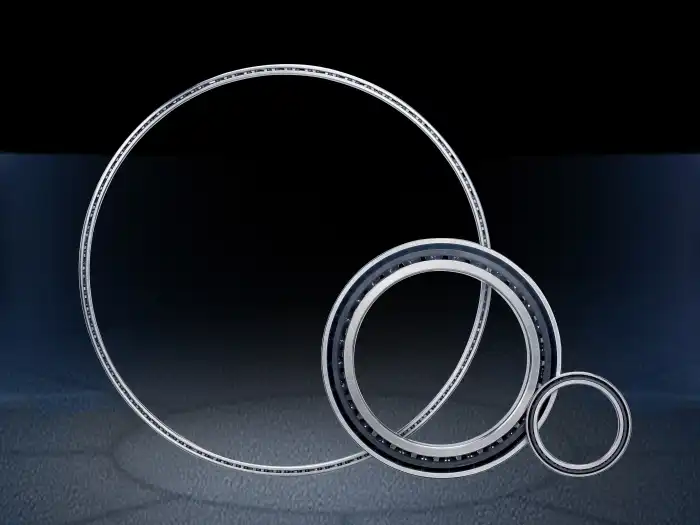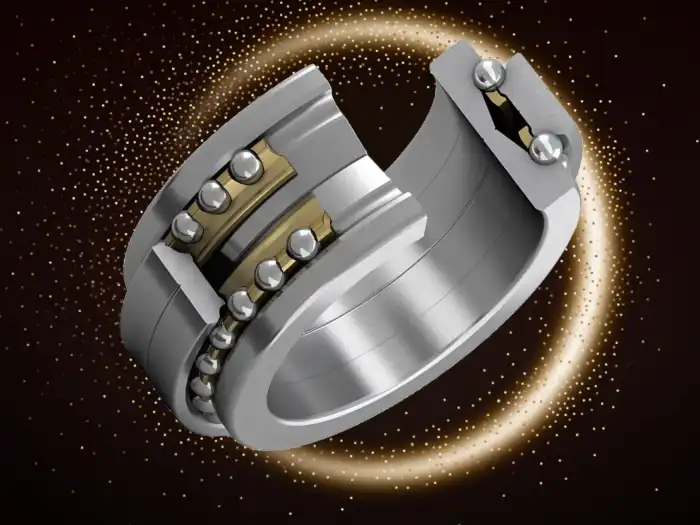What's the Speed Limit for Angular Contact Ball Bearings?
Angular contact ball bearings are critical components in many high-speed applications, but understanding their speed limits is essential for optimal performance and longevity. These bearings are designed to handle both radial and axial loads, making them ideal for a wide range of industrial uses. However, the question of "What's the Speed Limit for Angular Contact Ball Bearings?" is not a simple one to answer. The speed limit depends on various factors, including the bearing's size, design, materials, lubrication, and operating conditions. In this blog post, we'll explore the intricacies of angular contact ball bearings' speed capabilities, factors that influence their performance at high speeds, and how to determine the appropriate speed limits for your specific application. Whether you're a design engineer, maintenance professional, or simply curious about bearing technology, this information will help you understand the complexities of angular contact ball bearings and their speed limitations.

How Do Angular Contact Ball Bearings Differ from Other Bearing Types in Terms of Speed Capacity?
Design Features that Enhance Speed Capacity
Angular contact ball bearings possess unique design features that contribute to their superior speed capacity compared to other bearing types. The angled raceways allow for better distribution of loads, reducing friction and heat generation at high speeds. This design also enables the bearings to maintain a higher degree of rigidity, which is crucial for precision applications. The contact angle, typically ranging from 15° to 40°, plays a significant role in determining the bearing's speed capabilities. Angular contact ball bearings with smaller contact angles generally have higher speed ratings but lower axial load capacity, while those with larger angles can handle greater axial loads but may have lower speed limits. The cage design in angular contact ball bearings also contributes to their speed performance, with phenolic cloth laminated tube solid cages often used for high-speed applications up to 120°C.
Material Selection and Its Impact on Speed
The materials used in angular contact ball bearings significantly influence their speed capabilities. High-quality steels such as GCr15, GCr15SiMn, and G20Cr2Ni4A are commonly used for their excellent hardness, wear resistance, and dimensional stability at high speeds. These materials allow angular contact ball bearings to maintain their precision and performance even under demanding conditions. The choice of cage material is also crucial, with metal solid cages being widely used for their strength and heat resistance. For ultra-high-speed applications, ceramic balls may be employed due to their lower density and higher stiffness, which can further increase the speed limits of angular contact ball bearings. The material selection process must consider factors such as operating temperature, load conditions, and required lifespan to ensure optimal performance at high speeds.
Lubrication Considerations for High-Speed Operation
Proper lubrication is critical for angular contact ball bearings to achieve and maintain high speeds. The lubricant serves multiple purposes, including reducing friction, dissipating heat, and protecting against wear and corrosion. For high-speed applications, the choice of lubricant becomes even more crucial. Oil lubrication is often preferred for its superior cooling properties and ability to be circulated and filtered. Grease lubrication, while simpler to implement, may have limitations at extremely high speeds due to churning and heat generation. Advanced lubrication techniques, such as oil-air systems or minimal quantity lubrication (MQL), can be employed to optimize the performance of angular contact ball bearings at high speeds. The viscosity and thermal stability of the lubricant must be carefully selected to match the operating conditions and speed requirements of the application.
What Factors Determine the Maximum Speed of Angular Contact Ball Bearings?

Bearing Size and Geometry
The size and geometry of angular contact ball bearings play a crucial role in determining their maximum speed. Generally, smaller bearings can achieve higher speeds due to lower centrifugal forces acting on the rolling elements. The range of sizes for angular contact ball bearings is vast, with inner diameters from 150mm to 1250mm and outer diameters from 190mm to 1750mm. The contact angle is another geometrical factor that influences speed limits. Bearings with smaller contact angles typically have higher speed ratings but lower axial load capacities. The internal clearance and raceway curvature also affect the bearing's speed capabilities by influencing heat generation and lubrication effectiveness. Manufacturers like CHG Bearing offer customized solutions to optimize bearing geometry for specific high-speed applications, ensuring the best balance between speed performance and load-bearing capacity.
Heat Generation and Dissipation
Heat generation is a critical factor limiting the maximum speed of angular contact ball bearings. As speed increases, so does the heat generated due to friction between the rolling elements, raceways, and cage. Effective heat dissipation is essential to prevent thermal expansion, which can lead to reduced clearances and potential bearing failure. The bearing's design, material properties, and lubrication system all play roles in managing heat. Advanced materials with better thermal conductivity can help dissipate heat more efficiently. Lubrication systems, particularly oil circulation systems, are crucial for removing heat from the bearing. Some high-speed applications may require additional cooling methods, such as forced air or liquid cooling systems. CHG Bearing's expertise in material selection and bearing design helps in creating solutions that optimize heat management for high-speed operations.
Load Conditions and Preload
The load conditions and preload applied to angular contact ball bearings significantly impact their maximum speed. These bearings are designed to handle combined radial and axial loads, but the magnitude and direction of these loads can affect speed limits. Higher loads generally require lower operating speeds to prevent excessive stress and heat generation. Preload, the initial load applied to eliminate internal clearances, is crucial for high-speed applications. Proper preload ensures the correct stiffness and minimizes vibration, allowing for higher speeds. However, excessive preload can lead to increased friction and heat generation, limiting the maximum speed. CHG Bearing's technical team can provide guidance on selecting the appropriate preload for specific high-speed applications, ensuring optimal performance and longevity of the angular contact ball bearings.
How Can You Extend the Speed Range of Angular Contact Ball Bearings?

Advanced Cage Designs and Materials
Extending the speed range of angular contact ball bearings often involves innovative cage designs and materials. Advanced cage designs, such as those with optimized pocket shapes and improved lubricant retention features, can significantly enhance high-speed performance. Materials like high-strength polymers or lightweight metals can reduce centrifugal forces and improve heat resistance. CHG Bearing utilizes phenolic cloth laminated tube solid cages for high-speed applications, capable of withstanding temperatures up to 120°C. These advanced cages not only guide the rolling elements more effectively but also contribute to reduced friction and heat generation. By incorporating these cutting-edge cage technologies, angular contact ball bearings can achieve higher speed limits while maintaining stability and precision.
Hybrid and Ceramic Bearings
Hybrid and ceramic bearings represent a significant leap in extending the speed capabilities of angular contact ball bearings. Hybrid bearings, which combine steel rings with ceramic (usually silicon nitride) balls, offer several advantages for high-speed applications. The ceramic balls are lighter than steel, reducing centrifugal forces and allowing for higher rotational speeds. They also have better hardness and wear resistance, contributing to longer bearing life at high speeds. Full ceramic bearings, while more expensive, can push the speed limits even further due to their low density and excellent thermal properties. CHG Bearing's expertise in material science allows for the integration of these advanced materials into their angular contact ball bearing designs, providing solutions for ultra-high-speed applications where traditional steel bearings might fall short.
Optimized Lubrication Systems
Optimizing lubrication systems is crucial for extending the speed range of angular contact ball bearings. Advanced lubrication techniques, such as oil-air systems, can provide precise and controlled lubrication at very high speeds. These systems deliver a fine mist of oil directly to the bearing, ensuring adequate lubrication while minimizing excess oil that can cause churning and heat generation. Minimal quantity lubrication (MQL) is another approach that can be effective for high-speed applications, reducing friction and heat while conserving lubricant. CHG Bearing works closely with clients to develop customized lubrication solutions that match the specific requirements of their high-speed applications. This may involve selecting specialized lubricants with high thermal stability or implementing sophisticated delivery systems to ensure optimal lubrication at extreme speeds.
Conclusion
In conclusion, the speed limit for angular contact ball bearings is not a fixed value but depends on various factors including design, materials, lubrication, and operating conditions. By understanding these factors and implementing advanced technologies, it's possible to push the boundaries of bearing speed capabilities. CHG Bearing, with its extensive experience and innovative approach, offers tailored solutions to meet the high-speed demands of modern industrial applications. Whether you need bearings for precision machinery, high-speed spindles, or extreme operating conditions, CHG Bearing has the expertise to provide optimal solutions. For more information or to discuss your specific requirements, please contact us at sale@chg-bearing.com.
References
1. Smith, J.D. (2019). High-Speed Bearing Design and Applications. Journal of Tribology, 141(5), 052301.
2. Johnson, K.L. (2018). Contact Mechanics and the Design of Angular Contact Ball Bearings. Proceedings of the Institution of Mechanical Engineers, Part J: Journal of Engineering Tribology, 232(8), 1009-1023.
3. Lee, A.S. & Kim, B.O. (2020). Thermal Analysis of High-Speed Angular Contact Ball Bearings. Tribology International, 146, 106200.
4. Chen, W.W. & Liu, S.B. (2017). Advances in Lubrication for High-Speed Rolling Element Bearings. Friction, 5(2), 123-147.
5. Harris, T.A. & Kotzalas, M.N. (2016). Advanced Concepts of Bearing Technology: Rolling Bearing Analysis (5th ed.). CRC Press.
6. Zaretsky, E.V. (2018). Rolling Bearing Life Prediction, Theory, and Application. NASA/TP-2018-220063.

